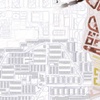The identity and sense of belonging of a neighborhood is a complex system of relationships, which is conditioned by multiple factors, among which time plays an essential role.
Our approach to the visual identity of the Fuencarral neighborhood is based on the analysis of its physical structure, and the perception that the neighbors have of it.
This relationship between the analysis of physical structure from a technical, historical and artistic point of view, and its feedback with the opinions of neighbors, has allowed a result that enhances the integration of the built with the social.
This study was undertaken to identify the most representative colors of the Fuencarral neighborhood. As the research progressed, we realized that it was necessary to incorporate other factors into our analysis, as visual identity cannot be fully understood solely through color.
Our field research and visits to the neighborhood revealed a variety of layers, textures, and finishes that contributed to the neighborhood's unique character. The residents of Fuencarral shared with us their appreciation for the neighborhood's urban structure and its low-rise housing typology, which they see as a reminder of traditional towns.
This collective sentiment helps to distinguish Fuencarral from the rest of Madrid.
However, the residents of Fuencarral do not express the same appreciation for the neighborhood's buildings and architecture.
This paradoxical relationship between urban morphology and architecture has been dubbed the "Fuencarral paradox."
Please, write to centerforsustainablecities@ie.edu if you required more information.
Notice that CreaMNN must approve the publication or dissemination of the report.
